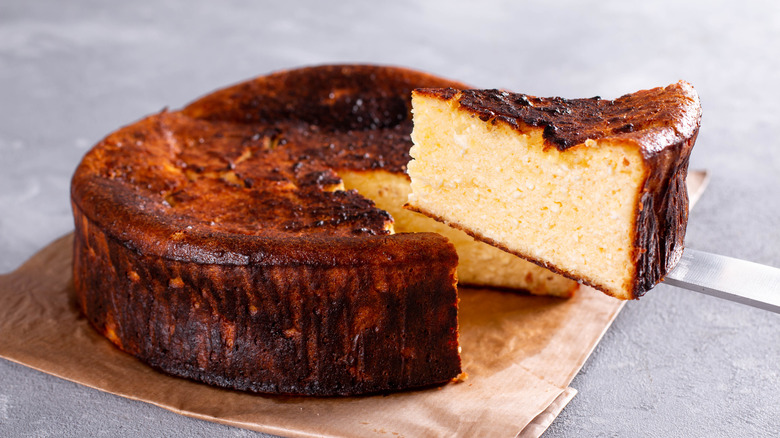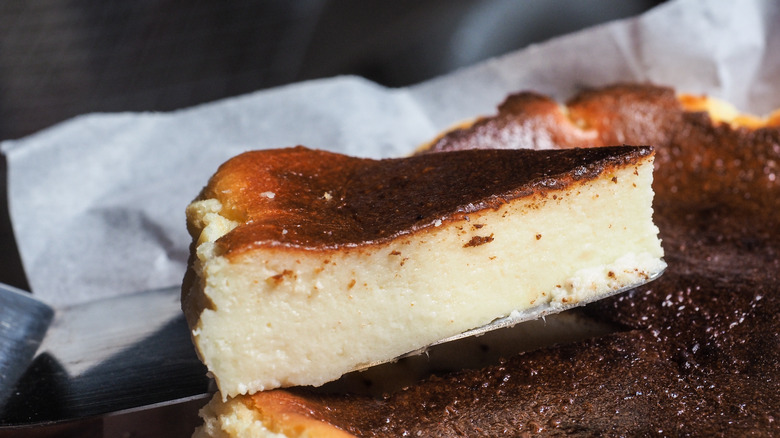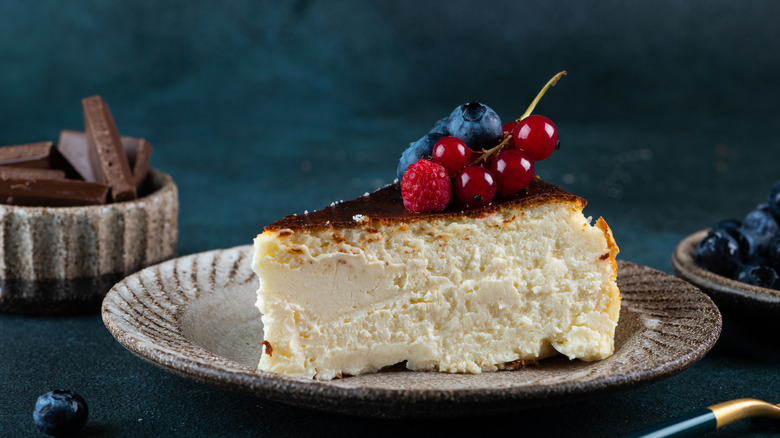What Makes Basque Cheesecake Unique?
The Spanish city of San Sebastián is far from unknown on the global culinary map. The city is the proud home of three three-Michelin-starred restaurants, giving the area more Michelin starred-restaurants per square kilometer than any other city except Kyoto, Japan, per Donostia San Sebastián.
The region is known for its "pintxos" or pinchos — bar snacks traditionally served on bite-sized slices of bread and eaten with toothpicks, and which include traditional favorites like tortilla de patatas, or more modern ones like a gourmet piece of grilled foie gras, per Eusk Guide. And aside from its small bites, San Sebastian is also known as the city that spawned a global craze for the ugly delicious dessert that is Basque cheesecake.
Unlike its American cousin, which is pure in its creamy white glory, Basque cheesecakes don't look delicate. In fact, they look like they may have been left in the oven for longer than intended — so much so that chefs like Tavel Bristol-Joseph, who have been making cheesecakes for years, say it was a challenge to make at first. He points out, "It's very difficult for someone who's been making cheesecake all their life... to literally put something in the oven and watch it burn," per Food and Wine.
Basque cheesecake defies our notion of what cheesecake looks like
SBS says what's known as Basque cheesecake, burnt cheesecake, or burnt Basque cheesecake was created three decades ago by Santiago Rivera, owner of pintxos cafe La Viña. Known as "tarta de queso" in its home city, the memorable cheesecake is said to have been the product of a one-day experiment — which resulted in the now global sensation that features a singed top as well as rough, jagged edges, all of which hide a heart of melty soft custard, per Taste.
The dessert stands out not only because it is delicious but also because it defies our ideas of what a cheesecake should be. As Bristol-Joseph tells Food and Wine, the chef initially thought that burning the cheesecake would leave the dessert bitter and smokey. Instead, he found the Basque cheesecake had not only developed a sweet, caramelized taste, but it also had vanilla undertones. This is thanks to the Maillard reaction, which also triggers an equally favorable change in flavors from grilled steak to aromatic roasted coffee beans, per Kosher.
Though it is made with many of the same ingredients as a standard cheesecake, the charred top isn't the only thing that sets the Basque cheesecake apart from its American counterparts. As MasterClass points out, this version is also without the graham cracker crust commonly found at the bottom of many American variations.
Tips on failure-proofing your Basque cheesecake
If you're not close to a restaurant or a dessert shop that offers Basque cheesecake, you can try and make one yourself. The recipe calls for sugar, cream cheese, kosher salt, eggs, heavy cream, and all-purpose flour, and MasterClass suggests bringing everything to room temperature, so it is easier to mix.
Chef Bristol-Joseph has other tips on how to failure-proof your Basque cheesecake too. Per Food and Wine, he advises not to overmix the batter to keep gluten from developing. He says using high-fat whipping cream is best. Bristol-Joseph further advises against the standard practice of using a water bath for cooking a cheesecake because it will prevent it from caramelizing. While the cheesecake is cooking, don't open the door, and use your eyes to test for doneness — color is everything. And when it's all done, allow the cake to chill overnight before serving... and devouring.


